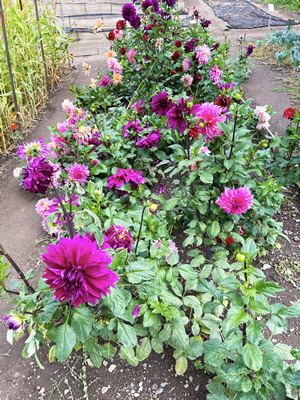Dahlia Project Update
By Suraya David-Sadira
FTT and Assistant Mini-Farm Manager, TJC

In 2021, we established an experimental 10-Bed Unit
at The Jeavons Center with a diet design including
dahlias as a versatile carbon/calorie/income crop.
This is an ongoing project, and we're still growing
dahlias in 2024, tweaking and improving the selection
and cropping technique. Suraya is working on a
Self-Teaching Mini-Series booklet that will give a
detailed account of her work with dahlias as a GROW
BIOINTENSIVE crop. So this is the final installment on
this series of articles—for now.
As a wrap-up, we've got
the highlights of what we've discovered so far, so that if
you want to try growing dahlias for biomass, calories,
and a beautiful crop of flowers, you can benefit from
what we've learned. You can find a good intro to edible dahlias here.
- Plant tubers horizontally, not vertically.
- Only water tubers once, when first planting and
then not again until sprouted.
- Prune dahlias down to 2 or 3 growth nodes when
they are 9” tall. This will encourage more bushing
and main stems to grow.
- Be sure to trellis dahlias to support their growth.
- When cutting flowers, cut with long stems to encourage
growth from lower nodes. 9-18” is usually
good.
- To increase dahlia’s vase life, cut flowers in the
morning when they are most hydrated, then, put
them in warm-hot water in a dark place until you
are ready to distribute them.
- Dahlia tubers are highly susceptible to root rot, so
don't over-water. You may need to dig them out in
the winter to prevent water damage, depending on
your growing zone and soil type. If you are in zone
8 or higher you can leave them in the ground, but
you will want to tarp or cover to protect from rain.
- When dividing tubers, it is important to make
sure each tuber has a viable and intact neck and
eye.
- When storing tubers, make sure to place them in
a material that can absorb moisture but not dry
them out. Shredded paper works great.
You can read about the tuber harvesting and dividing
process in my article from 2022, here.
♥
top | Newsletter Home |Table of Contents| Archive

|



